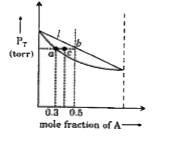0.48g of a substance was dissolved in 10.6 g C6H6. The freezing point of benzene was lowered by 1.8∘C. Calculate molar mass of the substance. Molecular depression constant for benzene is 5K kg mol−1.Solution in Malayalam
153.6g mol−1
125.79g mol−1
251.6g mol−1
89.42g mol−1
The correct Answer is:B
△T=100KfwmW
w=0.48g, W=10.6g, △Tf=1.8,Kf=5K kg mol−1
1.8=1000×5×0.48m×0.16 m=125.79 g mol−1
Topper's Solved these Questions
- SOLUTIONSBOOK - BRILLIANT PUBLICATIONCHAPTER - SOLUTIONSEXERCISE - Level II
50 Videos
- SOLUTIONSBOOK - BRILLIANT PUBLICATIONCHAPTER - SOLUTIONSEXERCISE - Level II (Assertion & Reason Type)
20 Videos
- SOLUTIONSBOOK - BRILLIANT PUBLICATIONCHAPTER - SOLUTIONSEXERCISE - Level-III (Linked Comprehension Type)
12 Videos
- SOLID STATEBOOK - BRILLIANT PUBLICATIONCHAPTER - SOLID STATEEXERCISE - LEVEL-3 (Linked Comprehension Type)
10 Videos
- STEREOCHEMISTRY BOOK - BRILLIANT PUBLICATIONCHAPTER - STEREOCHEMISTRY EXERCISE - LEVEL-II (ASSERTION - REASON TYPE)
2 Videos
Similar Questions
The volumes of two HCl solutions A (0.5N) and B(0.1N) to be mixed for preparing 2 L of 0.2 NHCl are:
View SolutionAssertion : If a liquid solute more volatile than the solvent is added to the solvent, the papour pressure of the solution may increase i.e. ps>p∘.
Reason In the presence of a more volatile liquid solute, only the solute will form the vapours and solvent will not.
View Solution1 mole of A and 1 mole B are mixed together to form an ideal solution at 25∘C. Solution is placed in a vessel fitted with piston. If pressure on the solution is reduced isothermally.

Correct relationship between P∘AandP∘B is
View SolutionF centre is an example of metal excess defect due to the presence of extra cations at interstitial sites. Zinc oxide is white in colour at room temperature, on heating it loses oxygen and turns yellow.
ZnOHeat−−→Zn2++12O2+2e−
Now there is excess of zinc in the crystal and its formula becomes Zn1+x O. the excess of Zn2+ ions move to interstitial sites and the electrons to neighbouring interstitial sites.
There are many solids which are difficult to prepare in the stiochiometric composition and contain less amount of the metal as compared to stiochiometric proportion. a typical example of this type is FeO which is mostly found with a composition of Fe0.95. it may actually range from Fe0.96 O.
Q. In Fe0.95 O:
View SolutionAssertion : Meso tartaric acid is optically inactive
Reason : Meso tartaric acid has a plane of symmetry
View Solution1.0gof a non-electrolyte solute (molar mass250gmol−1 was dissolved in 51.2 g of benzene. If the freezing point depression constant of benzene is 5.12Kkgmol−1 the lowering in freezing point will be
View Solution0.48 of a substance is dissolved in 10.6 g of C_(6)H_(6) .The freezing point of benzene is lowered by 1.8^(@)C what will be the mol.wt.of the substance ( K_(f) for benzene = 5 )
View Solution0.440 g of a substance dissolved in 22.2 g of benzene lowered the freezing point of benzene by 0.567∘C . The molecular mass of the substance is _____(Kf=5.12Kkgmol−1)
View Solution1.00 g of a non-electrolyte solute dissolved in 50g of benzene lowered the freezing point of benzene by 0.40 K. The freezing point depression constant of benzene is 5.12 K kg mol−1. Find the molar mass of the solute.
View Solution0.440 g of a substance dissolved in 22.2 g of benzene lowered the freezing point of benzene by 0.567∘C . The molecular mass of the substance is _____(Kf=5.12Kkgmol−1)
View Solution1.0 g of non - electrolyte solute dissolved in 50 g of benzene lowered the freezing point of benzene by 0.4 K. Find the molar mass of the solute. [Given : Freezing point depression constant of benzene = 5.12 K. kg mol].
View Solution0.48 g of a substane was dissolved in 10.6g C_(6)H_(6) . The freezing point of benzene was lowered by 1.8^(@)C . Calculate m.w.t. of the substance. Molecular depression constant for benzene is 50 K"mol"^(-1) 100 g .
View Solution2g of a non electrolyte solute dissolved in 75g of benzene lowered the freezing point of benzene by 0.20 k. The freezing point depression constant of benzene is 5.12 K Kg mol ^(-1). Find the molar mass of the solute.
View Solution1.0 g of non-electrolyte solute dissolved in 50.0 g of benzene lowered the freezing point of benzene by 0.40 K . The freezing point depression constant of benzene is 5.12 kg mol^(-1) . Find the molecular mass of the solute.
View Solution1.0 g of a non-electrolyte solute (molar mass 250 g mol−1) was dissolved in 51.2 g of benzene. If the freezing point depression constant of benzene is 5.12 K kg mol−1, the lowering in freezing point will be
View Solution
